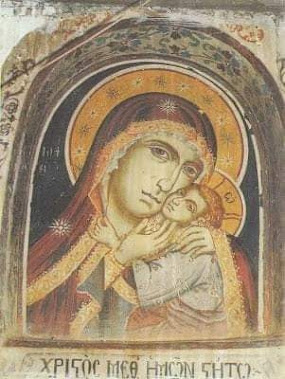Ἀπὸ τὰ πρῶτα χρόνια ἡ Ἐκκλησία ἔχει δώσει στὴ Μητέρα τοῦ Θεοῦ τίτλους ἁγιότητας μεγαλύτερους ἀπὸ ἐκείνους ποὺ ἔχουν δοθεῖ σὲ ὁποιονδήποτε ἄλλον Ἅγιο. Ὀνομάστηκε Ὑπεραγία, Παναγία. Τὴν εὐλαβούμαστε ὡς κάποια ποὺ εἶναι μεγαλύτερη καὶ ἁγιότερη ἀπὸ τὰ Χερουβὶμ καὶ τὰ Σεραφείμ, μεγαλύτερη ἀπ’ τοὺς ἀγγέλους τοῦ Θεοῦ ποὺ προικισμένοι μὲ τὴν ὅραση μποροῦν νὰ δοῦν, ν’ ἀτενίσουν καὶ νὰ λατρέψουν, ὡς κάποια ποὺ εἶναι μεγαλύτερη ἀπὸ τοὺς ἀγγέλους τοῦ Θεοῦ ποὺ εἶναι στὸν θρόνο τοῦ Ὑψίστου. Ἐπειδὴ αὐτοὶ ὅπως καὶ οἱ ἄλλοι βλέπουν, λατρεύουν καὶ ὑπηρετοῦν τὸ Θεὸ ὡς τὸν Κύριό τους, ὡστόσο παραμένουν κατὰ κάποιο τρόπο μακριὰ ἀπ’ Αὐτόν, σὲ σχέση μὲ ἐκείνη ποὺ στὴν ἀνυπέρβλητη ἁγιότητά της ἔγινε ἡ οἰκογένεια τοῦ Θεοῦ, ἡ Μητέρα τοῦ σαρκωμένου Λόγου, ἡ ὁποία εἶναι ἡ Νύμφη, ἡ τέλεια ἀποκάλυψη αὐτοῦ ποὺ ὁλόκληρη ἡ κτίση ἔχει κληθεῖ νὰ εἶναι καὶ νὰ γίνει.
Ἡ παράδοση λέει ὅτι ἀνατράφηκε ἀπὸ τὸν Ἰωακεὶμ καὶ τὴν Ἄννα. Στὶς εἰκόνες μπορεῖς νὰ δεῖς κορίτσια μὲ κεριὰ καθὼς τὴν φέρνουν στὸ ναό. Τὴν ὁδήγησαν στὸν Ἀρχιερέα, ὁ ὁποῖος τὴν πῆγε σ’ ἕνα μέρος ποὺ δὲν εἶχε πρόσβαση οὔτε ὁ ἴδιος.
Τώρα δὲ νομίζω πὼς ὑπάρχει κάποια πλεονέκτημα στὸ νὰ συζητᾶ κανεὶς τὴν πιθανὴ ἱστορικότητα ἑνὸς γεγονότος τέτοιου εἴδους. Ἐξεταζόμενο ἁπλὰ ἀπὸ ἱστορικῆς πλευρᾶς φαίνεται μᾶλλον δύσκολο νὰ ἔγινε κάτι τέτοιο. Ἀλλὰ ἐκεῖνο ποὺ ἔχει σημασία εἶναι τὸ τί ἀντιπροσωπεύει αὐτό· ἀντιπροσωπεύει μιὰ στιγμὴ κατὰ τὴν ὁποία, ἔχοντας φτάσει στὸ σημεῖο ὡρίμανσης ἑνὸς νέου παιδιοῦ, ἀλλὰ στὸ σημεῖο ὡρίμανσης κάποιου ποὺ μπορεῖ νὰ λατρέψει, νὰ ὑπηρετήσει, ν’ ἀκούσει, νὰ εἶναι ἕτοιμο νὰ ἀνταποκριθεῖ καὶ νὰ ὑπακούσει, αὐτὴ ἐπέλεξε ὅλα ἐκεῖνα καὶ μπῆκε στὰ βάθη τῆς ὑπακοῆς, τῆς ἀκοῆς, τῆς προσοχῆς στὸ θέλημα τοῦ Θεοῦ.
Μὲ αὐτὸ δὲν θέλω νὰ πῶ ὅτι αὐτὸ συνέβη ἢ δὲν συνέβη. Ἀλλά, ἀναφορικὰ μὲ ἐκείνη, αὐτὸ ποὺ μετράει εἶναι προφανῶς αὐτὴ ἡ θέαση τοῦ γεγονότος πολὺ περισσότερο ἀπὸ τὴν ἱστορικότητα τοῦ γεγονότος ποὺ περιγράψαμε στὶς εἰκόνες ἢ στὴ φολκλορικὴ παράδοση.
Μετάφραση .agiazoni.
Πρωτότυπο Κείμενο
Metropolitan Anthony of Sourozh
FEASTS OF THE MOTHER OF GOD
7 November, 1972
The Feast of the Presentation of the Mother of God to the Temple quite obviously raises historical problems. We know that in Israel no one was allowed into the Holy of Holies, that the High Priest entered it only once a year after having undergone purification by sacrificial blood. What the feast stands for primarily is described, enlarged on, in a sermon on prayer written in the 19th century by Theophane the Recluse. The Holy of Holies, he says, is the heart of hearts of human worship. It is the place where men in the Old Testament can meet God to the extent to which God can be met. It is the heart of the mystery of Israel. It is also the point which somehow is beyond the point of the sacrificed. The sacrifice opens the door to it. The sacrifice somehow remains this side of it. And to enter into the Holy of Holies means first and foremost to enter into that depth of adoration, into that depth of prayer which makes one present to the living God, which makes one stand face to face with the living God. The presentation of the Mother of God, apart from historical features, is extolled by the Church because it indicates to us where She stands in the whole of Her life, in the divine presence in complete surrender, in complete adoration.
Tradition has it that she was brought by Joachim and Anna. On the icons you can see young girls with candles bringing her to the temples. She was handed over to the high priest, who took Her into the place to which he had no access himself. Now I don\’t think there is any advantage in discussing the possible historicity of an event of that kind. From a purely historical point of view it is unlikely that it could have happened. But what matters is what it stands for, and it stands for a moment when, having reached the maturity of a young child, but the maturity of one who can already worship, serve, lend an ear, be ready to respond and to obey, She chose all that and went into that depth of obedience, of listening, of attention to what was God\’s will. By what I say I do not mean to say that it did or did not happen. But what matters as far as She is concerned is obviously this aspect of the thing much more than the historicity of the event as described in icons or in folkloric tradition.









































































































Δεν υπάρχουν σχόλια:
Δημοσίευση σχολίου